
If your solution to stated problem does not match the given solution, you should self-critique per instructions at
http://vhcc2.vhcc.edu/dsmith/geninfo/labrynth_created_fall_05/levl1_22/levl2_81/file3_259.htm
.
Your solution, attempt at solution. If you are unable to attempt a solution, give a phrase-by-phrase interpretation of the problem along with a statement of what you do or do not understand about it. This response should be given, based on the work you did in completing the assignment, before you look at the given solution.
012. Equations and Properties of Parabolas, hyperbolas and ellipses
Question: `q001. The set of points which lie at equal distances from a point (x0, y0) and a line y = c is called a parabola. The line y = c is called the directrix and the point (x0, y0) the focus of the parabola. The vertex of the parabola is the point halfway between the focus and the directrix.
What is the vertex of the parabola whose focus is at (7, 4) and whose directrix is y = 2? How far is it from the vertex of this parabola to the focus?
Your solution:
Confidence Assessment:
Given Solution:
`aFigure 74 shows the point (7,4), now identified as the focus, and the line y = 2, now identified as the directrix. Recall that in the previous exercise set we located points which were equidistant from this line and point. These points are again shown, along with the curve (a parabola) consisting of all such points.
The vertex is the point halfway between the focus and the directrix; this point clearly has coordinate form (7, 3), lying 1 unit lower than the focus and one unit higher than the directrix.
We often use a to represent the displacement from vertex to focus, or directrix to vertex.

Self-critique (if necessary):
Self-critique Rating:
Question: `q002. The equation (y - k) = 1 / (4 a) * ( x - h )^2 describes the parabola with vertex (h, k) and displacement a from vertex to focus. Give the equation of the parabola from the preceding problem whose focus is at (7, 4) and whose directrix is at y = -2.
Your solution:
Confidence Assessment:
Given Solution:
`aThe vertex is at (h, k) = (7, 3) and as seen in the preceding solution we have a = 1. Thus the equation is
(y - 3) = 1 / (4 * 1) * (x - 7)^2, which simplifies to
y - 3 = 1/4 * (x - 7)^2.
Note that this is identical with the solution obtained in the preceding exercise, where we simplified the equation sqrt( (x-7)^2 + (y-4)^2 ) = y - 2, representing the statement that the distance from (7,4) to (x,y) is equal to the distance from (x,y) to the line y = 2. After several steps of simplification we obtained the form (y - 3) = 1/4 ( x - 7)^2.
Self-critique (if necessary):
Self-critique Rating:
Question: `q003. What is the equation of the parabola whose vertex is at (7, 3) and whose focus is at (7, 4)? Sketch this parabola and describe its graph.
Your solution:
Confidence Assessment:
Given Solution:
`aFigure 35 illustrates the parabola, whose vertex lies 1 unit lower than the focus and whose directrix must therefore lie 1 unit lower than the vertex (recall that the displacement between vertex and focus is the same as the displacement from the directrix to the vertex). The directrix is therefore the line y = 2.
The equation of the parabola is (y - k) = 1 / (4 a) * (x - h)^2, where (h,k) is the coordinate form of the vertex and a is the displacement from vertex to focus.
Thus (h, k) = (7, 3) so h = 7 and k = 3, while a is the -1 unit displacement from vertex to focus.
The equation of the parabola is therefore
y - 3 = 1 / (4 * -1) * (x - 7)^2, or
y - 3 = -1/4 * (x-7)^2.

Self-critique (if necessary):
Self-critique Rating:
Question: `q004. The set of points the sum of whose distances from the two given points (0, c) and (0, -c) is equal to 2b is called an ellipse. Its equation is x^2 / a^2 + y^2 / b^2 = 1, where a^2 = b^2 - c^2. The points (0, -c) and (0, c) are called the foci of the ellipse; each individual point is called a focus. What is the equation of the ellipse with foci at (0, -3) and (0, 3) for which a = 4?
Your solution:
Confidence Assessment:
Given Solution:
`aThe coordinates of the foci are (-c, 0) and (c, 0), identified here as (-3,0) and (3,0). So we know that c = 3.
Since a = 4 and a^2 = b^2 - c^2 we have b = sqrt(a^2 + c^2) = sqrt(4^2 + 3^2) = sqrt(25) = 5.
So the equation of the given ellipse is
x^2 / a^2 + y^2 / b^2 = 1, with a = 4 and b = 5, or
x^2 / 4^2 + y^2 / 5^2 = 1, also written as
x^2/16 + y^2/25 = 1.
Self-critique (if necessary):
Self-critique Rating:
Question: `q005. What are the x intercepts of the ellipse with foci at (0, -3) and (0, 3) for which a = 4? What are the y intercepts?
Your solution:
Confidence Assessment:
Given Solution:
`aThe x intercepts of an equation lie at the points where y = 0. So the x intercepts of the equation x^2/16 + y^2/25 = 1 occur when x^2/16 + 0^2/25 = 1. We easily solve the resulting equation:
x^2/16 = 1 so that
x^2 = 16 and
x = +- sqrt(16) = +-4.
In general the equation x^2 / a^2 + y^2 / b^2 = 1 has x intercepts at x = +-a and y intercepts at y = +-b.
The y intercepts of an equation lie at the points where x = 0. So the y intercepts of the equation x^2/16 + y^2/25 = 1 occur when 0^2/16 + y^2/25 = 1. We easily solve the resulting equation:
y^2/25 = 1 so that
y^2 = 25 and
y = +- sqrt(25) = +-5.
In general the equation x^2 / a^2 + y^2 / b^2 = 1 has x intercepts at x = +-a and y intercepts at y = +-b.
Self-critique (if necessary):
Self-critique Rating:
Question: `q006. Sketch the rectangle formed by the lines x = -4, x = 4, y = -5, and y = 5. Sketch the ellipse circumscribed by this rectangle (this will be the largest ellipse you can fit into the rectangle). What is the equation of this ellipse? What are the coordinates of its foci?
Your solution:
Confidence Assessment:
Given Solution:
`aThe rectangle is shown in Figure 99, bounded by the vertical lines x = 4 and x = -4 and by the horizontal lines y = 5 and y = -5.
The largest possible ellipse inside the rectangle is shown in Figure 33, intersecting the rectangle at the points (-4,0), (4,0), (0, -5) and (0, 5).
Note that the x intercepts of this ellipse are the same as for the equation x^2 / 16 + y^2 / 25 = 1. The general method for sketching an ellipse of this form is to draw vertical lines through the x intercepts and horizontal lines through the y intercepts to form a rectangle. The ellipse can then be inscribed in the rectangle as was done here.
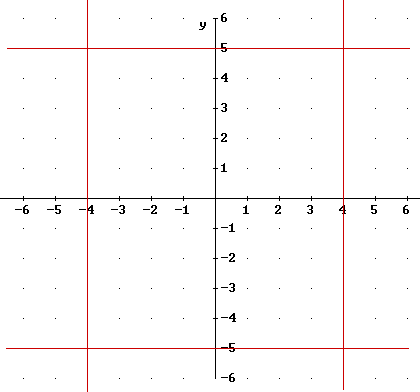
Self-critique (if necessary):
Self-critique Rating:
Question: `q007. If an ellipse from any of the the preceding exercises is shifted so that its center lies at (h, k) rather than (0, 0), then x and y in its equation will be replaced by (x-h) and (y-k). The rest of its equation will remain the same. What will be the equation of the ellipse which fits into the rectangle defined by the lines x = -2, x = 6, y = -4 and y = 6?
Hints: What is the center of this rectangle? If this rectangle is shifted so that the center moves to (0, 0) what will be the values of a and b, and what therefore will be its equation? So what is its equation in its actual position?
Your solution:
Confidence Assessment:
Given Solution:
`aThe given rectangle is shown in Figure 13. The center of the rectangle will lie halfway between x = 2 and x = 10, at x = (-2 + 6) / 2 = 2, and halfway between y = -4 and y = 6, at y = (-4 + 6) / 2 = 1. The rectangle is therefore centered at (2, 1).
If we shifted the rectangle so that the center was that (0, 0), we would have to shift -2 units in the x direction and -1 unit in the y direction. This would shift the lines x = -2 and x = 6 to x = -4 and x = 4, and the lines y = -4 and y = 6 to y = -5 and y = 5.
This rectangle would give us the ellipse centered at the origin having intercepts at (-a, 0) = (-4, 0) and (a, 0) = (4, 0), as well as at (-b, 0) = (-5, 0) and (b, 0) = (5, 0). Thus we have a = 0 and b = 0 and the ellipse would have equation x^2 / a^2 + y^2 / b^2 = x^2 / 16 + y^2 / 25 = 0.
Shifting this ellipse back to its original position with center at (h, k) = (2, 1), we replace x by x - h = x - 2 and y by y - h = y - 1 to obtain the equation
(x-2)^2 / 16 + (y - 1)^2 / 25 = 1.
This ellipse is shown in Figure 38.


Self-critique (if necessary):
Self-critique Rating:
Question: `q008. The set of points whose distances from the two given points (c, 0) and (-c, 0) differ by 2a is called a hyperbola. Its equation is x^2 / a^2 - y^2 / b^2 = 1, where c^2 = a^2 + b^2. The points (-c, 0) and (c, 0) are called the foci of the hyperbola; each individual point is called a focus. What is the equation of the hyperbola with foci at (0, -sqrt(41)) and (-, sqrt(41)) (these points are at approximately (0, +-6.4) for which a = 4?
Your solution:
Confidence Assessment:
Given Solution:
`aThe hyperbola with foci at ( +-c, 0) = (+-sqrt(41), 0), for which a = 4, has b^2 = c^2 - a^2 = sqrt( (41) )^2 - 4^2 = 41 - 16 = 25, so that b = sqrt(25) = 5.
The foci are on the y axis. The foci therefore occur when x = 0, so the vertices of the hyperbola are on the y axis. The term y^2 / b^2 must therefore be positive (if it was negative, then x = 0 would result in -y^2 / b^2 = 1, which is impossible because -y^2 / b^2 is negative and 1 is not).
So the hyperbola has the form
y^2 / b^2 - x^2 / a^2 = 1, or
y^2 / 5^2 - x^2 / 4^2 = 1, which simplifies to
y^2 / 25 - x^2 / 16 = 1.
Self-critique (if necessary):
Self-critique Rating:
Question: `q009. Sketch the rectangle formed by the lines x = -4, x = 4, y = -5, and y = 5, using a scale for which the rectangle is fairly small. Sketch the hyperbola defined by this rectangle as follows:
First sketch the diagonals of the rectangle, extending them well beyond the rectangle itself. Start at (4, 0) and sketch a curve that starts parallel to the vertical side of the rectangle, then as it rises curves away from the rectangle and becomes asymptotic to the extended diagonal which moves upward and to the right.
Then staring again at (4, 0) move downward, gradually curving away from the vertical to become asymptotic to the extended diagonal which moves downward and to the right. You will have sketched the part of the hyperbola whose vertex is at (4,0) and opens to the right.
Then sketch the part of the hyperbola which starts at (-4, 0) and opens to the left. This part will be symmetric with the part that opens to the right.
Your solution:
Confidence Assessment:
Given Solution:
`aThe rectangle is shown in Figure 82. The diagonals are included in this figure. The hyperbola will have two branches, one starting at (4, 0) and opening to the right. This hyperbola will approach the diagonals as its asymptotes. The other branch starts at (-4, 0) and opens to the left, again approaching the diagonals as its asymptotes.
The hyperbola is shown in figure 85.
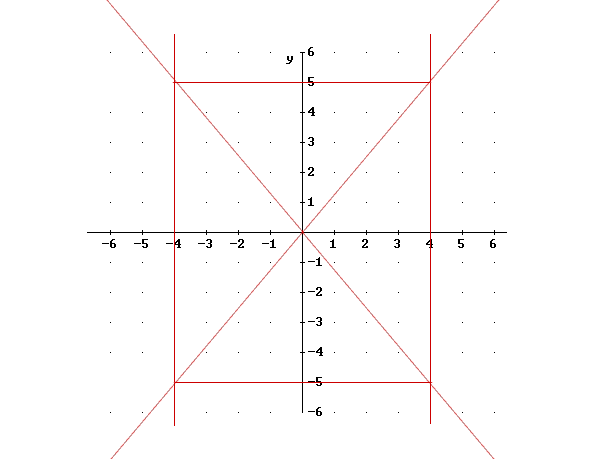
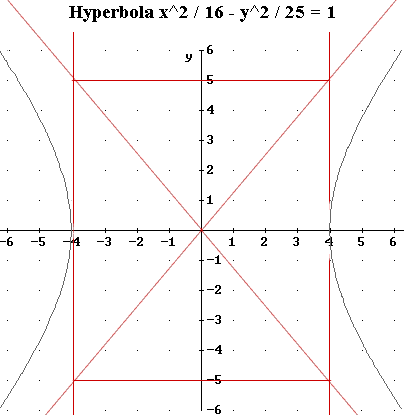
Self-critique (if necessary):
Self-critique Rating:
Question: `q010. How does the shape of the hyperbola you just sketched differ from that of a parabola?
Your solution:
Confidence Assessment:
Given Solution:
`aThe parabolas we have encountered so far in the course open upward or downward, while the hyperbola we see here opens to the right and to the left. This however is not really a difference between parabolas and hyperbolas, since parabolas can also open to the right or to the left (but not both on the same parabola). One difference is that a hyperbola has two branches and a parabola does not. Also the hyperbola to approaches asymptotes whereas a parabola never approaches any fixed line. A parabola which opens upward or downward keeps getting steeper and steeper, without limit.
Self-critique (if necessary):
Self-critique Rating:
Question: `q011. What are the equations of the diagonals of the rectangle you sketched? How are the equations of the diagonals related to the equation of the hyperbola?
Your solution:
Confidence Assessment:
Given Solution:
`aThe diagonals both pass through the origin. One has a slope of 5/4 and the other a slope of -5/4, so the equations of the diagonals are y = 5/4 x and y = -5/4 x.
The equation of the hyperbola is x^2 / 16 - y^2 / 25 = 1. Solving for y we have y = +-sqrt [ 25 ( x^2 / 16 + 1) ]. For very large x and y, the 1 on the right-hand side is not very significant and we therefore effectively have
y = +-sqrt[ 25 x^2 / 16 ](good approximation for large x).
sqrt(25 x^2 / 16) = 5 x / 4 so for large x our approximation becomes
y = +- 5 x / 4,
which is identical to the equations of the asymptotes.
Self-critique (if necessary):
Self-critique Rating:
Question: `q012. Sketch the rectangle formed by the lines x = -4, x = 4, y = -5, and y = 5, using a scale for which the rectangle is fairly small. Sketch the hyperbola defined by this rectangle as follows:
First sketch the diagonals of the rectangle, extending them well beyond the rectangle itself. Start at (0, 5) and sketch a curve that starts parallel to the horizontal side of the rectangle, then as it moves to the right curves away from the rectangle and becomes asymptotic to the extended diagonal which moves upward and to the right.
Then staring again at (0, 5) move to the left, gradually curving away from the horizontal to become asymptotic to the extended diagonal which moves upward and to the left. You will have sketch the part of the hyperbola whose vertex is at (5,0) and opens upward.
Then sketch the part of the hyperbola which starts at (0, -5) and opens downward.
Your solution:
Confidence Assessment:
Given Solution:
`aFigure 51 shows the hyperbola as described. It is not completely clear from the sketch how the hyperbola approaches its asymptotes. The approach to the asymptote is illustrated for the lower branch in the subsequent figure.
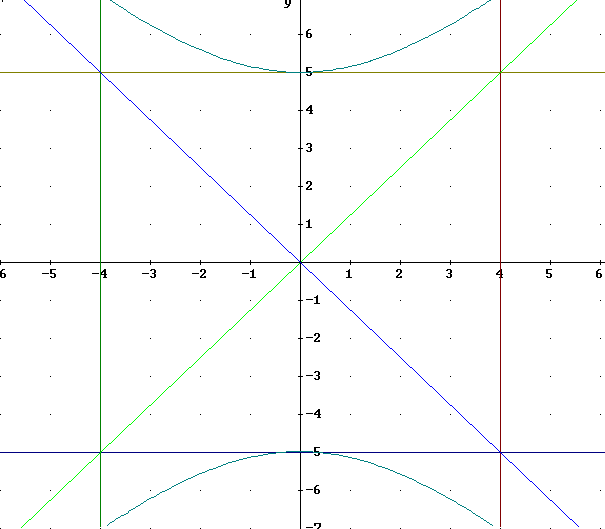
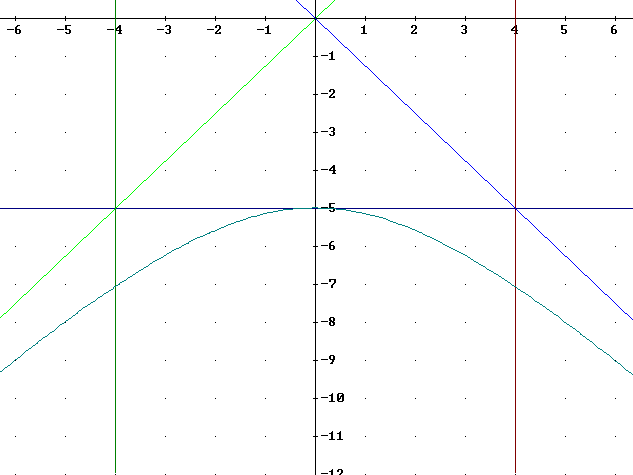
The figures below depict the same hyperbola as above, but shifted 2 units in the horizontal direction and 1 unit in the vertical direction. The construction is very similar to the preceding, except that the lines x = +- 4 are shifted 2 units to the right, becoming x = -2 and x = 6, while the vertical lines y = +- 5 are shifted to y = -4 and y = 6. The center is shifted from (0, 0) to (2, 1).
The original hyperbola had equation y^2 / 25 - x^2 / 16 = 1. The shift is accomplished by replacing x by x - 2 and y by y - 1 to obtain the equation for the hyperbola:
equation of shifted hyperbola: (y - 1)^2 / 25 - (x - 2)^2 / 16 = 1.

Approach to asymptote:

Self-critique (if necessary):
Self-critique Rating:
Question: `q013. The hyperbola you just sketched, which opens upward, has equation y^2 / b^2 - x^2 / a^2 = 1 and its foci lie at (0, c) and (0, -c). What is the equation of this hyperbola?
Your solution:
Confidence Assessment:
Given Solution:
`aThe foci of the parabola were given as (0, -c) = (0, -3) and (0, c) = (0, 3), so c = 3. The value of b is that of the y intercepts so b = 5. It follows that a^2 = b^2 - c^2 = 5^2 - 3^2 = 16, so that a = sqrt(16) = 4.
The equation is therefore
y^2 / b^2 - x^2 / a^2 = 1, or
y^2 / 5^2 + x^2 / 4^2 = 1, or
y^2 / 25 - x^2 / 16 = 1.
Self-critique (if necessary):
Self-critique Rating:
Question: `q014. The hyperbola y^2 / b^2 - x^2 / a^2 = 1 has points on the 'top' and 'bottom', not on the 'right' and 'left' of the defining rectangle. How can you tell this from the equation?
How can you tell that the equation x^2 / a^2 - y^2 / b^2 = 1 must have points at the 'right' and 'left' but not at the 'top' and 'bottom' of the defining rectangle?
Your solution:
Confidence Assessment:
Given Solution:
`aFor the equation y^2 / b^2 - x^2 / a^2 = 1, the y-intercept will lie at the x = 0 points, where y^2 / b^2 - 0^2 / a^2 = 1. Simplifying this equation we have y^2 / b^2 = 1, or y^2 = b^2 so that y = +-b.
However if we attempt to find the x intercepts we substitute y = 0 and obtain -x^2 / a^2 = 1. This equation has no solution since x^2 and a^2 are both positive, making - x^2 / a^2 negative. Since the negative quantity cannot equal 1, there is no x intercept--so, there is no graph point on the right and left sides of the defining rectangle.
For the equation x^2 / a^2 - y^2 / b^2 = 1 we see by letting y = 0 that the x intercepts are x = +-a, but if we let x = 0 we get the equation - y^2 / b^2 = 1, with no solution. We therefore have x intercepts but not y intercepts--i.e., points on the right and left sides of the rectangle but not on top and bottom.